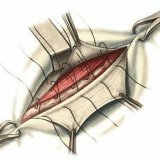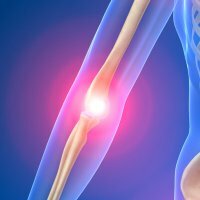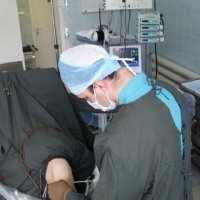Injury of the hernia and peculiarities of their surgical treatment

On the mechanism of formation of a hernia are divided:
1. congenital hernia;
2. acquired hernia;
3. traumatic or postoperative hernia.
Hernias can be without complications( correct or free) and complicated( with the phenomenon of inflammation, coprostasis, irreparable and strangulated).
Let's consider, such infringements of a hernia and features of their surgical treatment.
Infringement of a hernia is a squeezing of the hernial contents in the hernia gates. Any organ located in the abdominal cavity may be a hernial contents.
As it is commonly believed, irrespective of which body was infringed, the infringement consists of three factors:
1. impaired circulation of the injured organ;
2. violation of the functional capacity of this body;
3. general phenomena, expressed in a degree, depending on the importance of the organ in the human body.
Unfortunately, the mechanism of infringement of a hernia of any organ and features of its surgical treatment remain in some way a riddle for experts, despite the fact that surgeons are engaged in this problem for a long time. Already in the second half of the XVII century doctors tried to unravel this phenomenon. Then the cause of the infringement of the hernia was considered to be coprostasis, the intestinal entrapment.
In modern medicine distinguish calorie infringement, elastic infringement and association of these infringements simultaneously.
What determines the mechanism of infringement of a hernia?
As is known, the peritoneum of the hernial sac and the tissue of the hernia gates have a certain amount of elasticity. Elasticity is greatest in children and is small in the elderly. Also, the elasticity is affected by the cicatrical process of connective tissue due to the transferred inflammatory diseases. If we represent the peritoneum of the hernial sac and the tissue of the hernial gates in the form of an elastic ring, then we can clearly reproduce the mechanism of infringement of the hernia. When carrying an object through an elastic ring, the ring will compress this object. Also occurs and with infringement of a hernia. Holes in the hernial gates squeeze the abdominal organ that fell into them.
If this is a crippling infringement, there is an infringement of the intestinal loop, in which a high amount of fecal matter enters under increased pressure, which leads to a mismatch in the size of the hernial opening of the gates and the intestinal loop.
Infringement of a hernia is divided into two varieties - parietal and reverse( retrograde).With retrograde infringement, the loop, located in the abdominal cavity and representing the knee of two loops in the hernial sac, undergoes the most severe change.
Retrograde infringement was first described in 1880 at the autopsy. The term began its circulation in medicine since 1895, when the contraction of the vermiform appendage of the uterine tube was observed.
Pristenochnoe infringement of a gut is considered as the most difficult for diagnostic researches as at it intestinal patency is not broken. Most often, parietal infringement is observed in the occurrence of umbilical hernias and occurs with a frequency of up to 6% of all cases of infringement of the hernia.
Infringement of a hernia.
As for the reasons for infringement of the hernia and their surgical treatment, they are divided into "predisposing" and "producing".Predisposing reasons include individual characteristics of the patient( age, sex, development of muscles).It is customary to include cicatricial changes in the hernial sac, the presence of inflammatory processes, an increase in intra-abdominal pressure, etc.
Depending on the causes of the infringement of the hernia, a method of surgical treatment is chosen. One basic rule should be remembered - a hernia can be cured only by surgical intervention!
In modern medicine, the peculiarities of surgical treatment of infringement of hernias are not much different from surgical options for other diseases of the abdominal cavity. There are quite a lot of them, but the main ones are open operations and endoscopic operations.
Currently, both methods, subject to surgical intervention by qualified and experienced specialists, are considered permissible. The decision to use this or that variant of surgical treatment should be made by the board of surgeons in each case, taking into account the characteristics of the disease. When choosing an operation variant, both the physical condition of the patient and the features of the disease are taken into account - the pathogenesis of the hernia, its shape, the size of the hernial sac, the condition of the abdominal wall, etc.
Experienced specialists in the operation of hernioplasty will be able to choose the optimal method( only for inguinal herniaThe size of options for surgical intervention is several dozen) and as precisely as possible perform surgical treatment. One of the features of surgical treatment of hernia infringement is the precise performance of surgical manipulations and a qualified surgeon's technique. If all stages of surgical intervention are performed correctly, then the probability of recurrence of the hernia is minimized.
In the event of an infringement of the hernia, the speed of diagnosis and decision-making regarding the application of a particular treatment method is important, since sometimes the delay can end fatal for the patient. Such a danger is the infringement of the hernia with the development of necrosis of the intestine. When this dangerous disease occurs, even such contraindications to the operation as cardiovascular insufficiency, heart attack, stroke, diabetes mellitus in severe form, etc., recede into the background. Rescue of life by the patient can only be an emergency surgery.
Infringement of hernia and features of their surgical treatment should be considered by modern doctors not as planned standard operations, but as, for the most part, emergency surgical interventions with the use of highly skilled surgical techniques.



